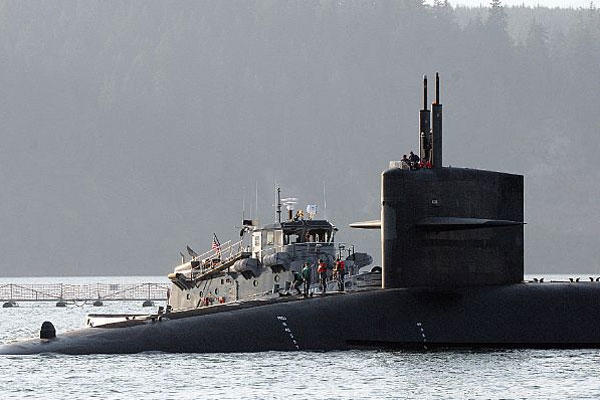U.S. national security officials are concerned about the pace and intensity of Russian submarine development, Chief of Naval Operations Adm. Jon Greenert said Thursday.
"There are competitors that are pursuing us. We know about China. That is very well spelled out, but not as many people know what the Russians are up to. I can't go into detail, obviously, but they spend a lot of money. The Russians have been working on a sea-based strategic deterrence - and an SSN (attack submarine)," Greenert said at the Naval Submarine League's annual symposium in Falls Church, Va.
Senior Navy leaders spelled out how Russian and Chinese are increasing defense spending year-to-year when compared with the U.S. The U.S. spends more overall than both Russian and China, but the gap is shrinking, something that is a concerning trend for U.S. Navy leaders.
Russia reportedly plans to sell a variant of its new Amur 1650 attack submarine to the Chinese. The Amur 1650 is a modern version of the Kilo-class Russian submarine with improved acoustic stealth, new combat systems, and air-independent propulsion, according to a report in the Inquisitr.
The website also reported that the Russian military successfully tested a Bulava intercontinental ballistic missile, or ICBM, launched from a Russian nuclear submarine, the Vladimir Monomakh. The U.S. Navy believes that the newest of China's nuclear submarines, the Jin SSBN, would mark China's first credible at-sea-second-strike nuclear capability, according to the report.
Greenert said the U.S. Navy is taking its own strides to advance its submarine fleet as the Ohio Replacement Program, or ORP, is in the early stages of development. The U.S. Navy plans to begin construction of a new class of 12 next-generation, quiet and stealthy nuclear-armed submarines able to provide what's called strategic nuclear deterrence.
Undersea strategic nuclear deterrence means that in the unlikely event of a catastrophic first-strike against the U.S. using nuclear weapons, the presence of nuclear-armed submarines in the ocean could guarantee a defensive response.
Greenert called the ORP a top priority. Construction work on the first Ohio Replacement submarines, slated for completion by 2021, is already underway at an Electric Boat facility in Rhode Island.
Funding requirements for the development and construction of the Ohio Replacement program will put tremendous pressure upon the Navy's annual shipbuilding budget, Greenert said.
Greenert referred to the reality that current funding levels will not allow for the Ohio Replacement program to co-exist alongside other shipbuilding programs such as destroyers, carriers, amphibs and cruiser upgrades.
In fact, the Navy's recently released 30-year shipbuilding plan specifies that there is not enough money in the current budget to fund the Ohio Replacement program while maintaining other shipbuilding priorities.
The plan, called the "Report to Congress on the Annual Long-Range Plan for Construction of Naval Vessels for FY2015," breaks down required funding for future ships into three ten-year blocks and specifies that the Navy will need $19.7 billion per year for shipbuilding from 2025 through 2034 due to the expected production of the Ohio Replacement Program.
"The average cost of this plan during the period which the [Department of the Navy] is procuring OR SSBN (Ohio Replacement) cannot be accommodated by the Navy from existing resources," the plan states.
Production for the lead ship in a planned fleet of 12 ORPs is expected to cost $12.4 billion - $4.8 billion in non-recurring engineering or development costs and $7.6 billion in ship construction, the plan states. Detailed design for the first ORP is slated for 2017 and some development and early construction is already underway. The Ohio Replacement Program is scheduled to serve out through the 2080s.
"If the DON [Department of the Navy] is unable to sustain the average annual shipbuilding budgets of $19.7 billion over the course of the mid-term planning period, which is unlikely to be the case, the battle force will fall short of meeting requirements," the plan states.
Overall, the Navy needs to make more progress if it hopes to meet its goal of producing the Ohio Replacement Submarines for $4.9 billion each in 2010 dollars.
Working with ORP-builder Electric Boat, a subsidiary of General Dynamics Corp., the Navy has finished the ship specifications for the boat and made progress with a few cost-cutting initiatives.
-- Kris Osborn can be reached at Kris.Osborn@military.com

























